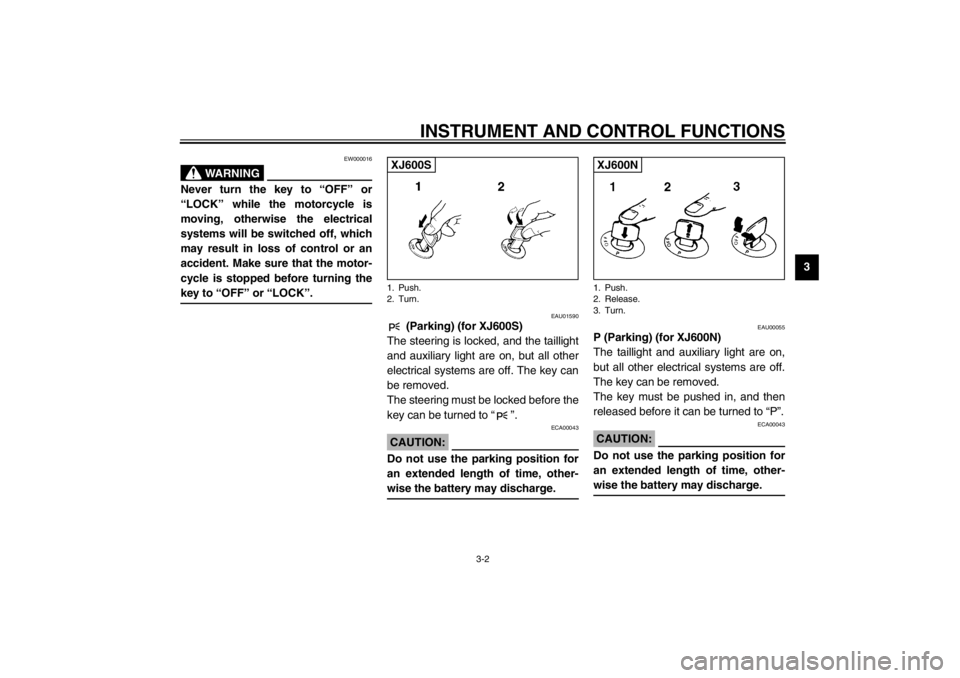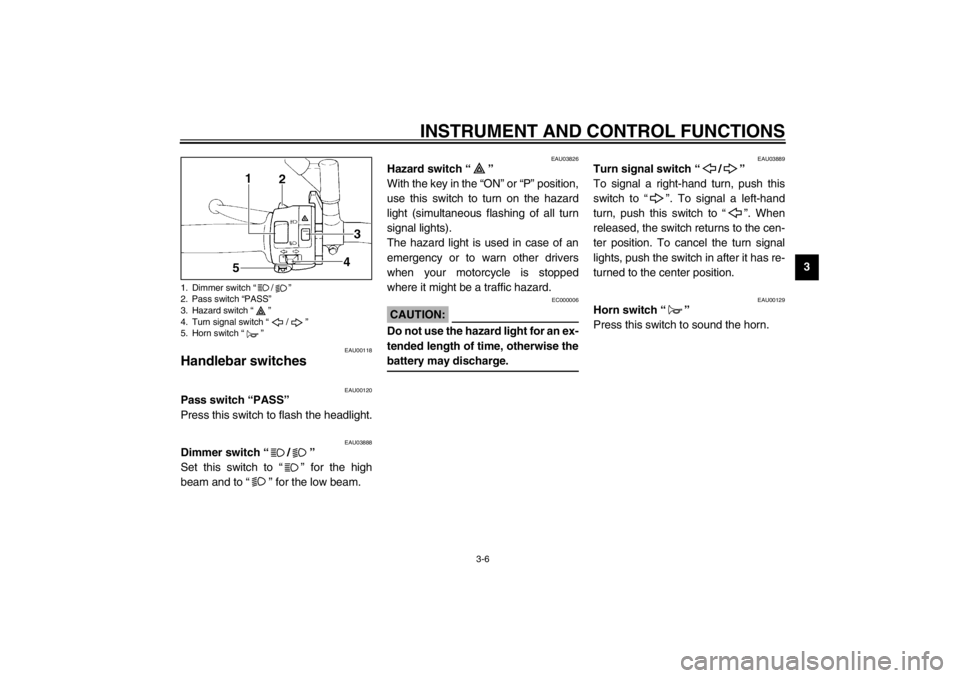Page 21 of 104

INSTRUMENT AND CONTROL FUNCTIONS
3-2
3
EW000016
WARNING
@ Never turn the key to “OFF” or
“LOCK” while the motorcycle is
moving, otherwise the electrical
systems will be switched off, which
may result in loss of control or an
accident. Make sure that the motor-
cycle is stopped before turning the
key to “OFF” or “LOCK”. @
EAU01590
(Parking) (for XJ600S)
The steering is locked, and the taillight
and auxiliary light are on, but all other
electrical systems are off. The key can
be removed.
The steering must be locked before the
key can be turned to “”.
ECA00043
CAUTION:@ Do not use the parking position for
an extended length of time, other-
wise the battery may discharge. @
EAU00055
P (Parking) (for XJ600N)
The taillight and auxiliary light are on,
but all other electrical systems are off.
The key can be removed.
The key must be pushed in, and then
released before it can be turned to “P”.
ECA00043
CAUTION:@ Do not use the parking position for
an extended length of time, other-
wise the battery may discharge.@
1. Push.
2. Turn.XJ600S
1. Push.
2. Release.
3. Turn.XJ600N
E_4br.book Page 2 Wednesday, July 25, 2001 1:40 PM
Page 25 of 104

INSTRUMENT AND CONTROL FUNCTIONS
3-6
3
EAU00118
Handlebar switches
EAU00120
Pass switch “PASS”
Press this switch to flash the headlight.
EAU03888
Dimmer switch “/”
Set this switch to “” for the high
beam and to “” for the low beam.
EAU03826
Hazard switch “”
With the key in the “ON” or “P” position,
use this switch to turn on the hazard
light (simultaneous flashing of all turn
signal lights).
The hazard light is used in case of an
emergency or to warn other drivers
when your motorcycle is stopped
where it might be a traffic hazard.
EC000006
CAUTION:_ Do not use the hazard light for an ex-
tended length of time, otherwise the
battery may discharge. _
EAU03889
Turn signal switch “/”
To signal a right-hand turn, push this
switch to “”. To signal a left-hand
turn, push this switch to “”. When
released, the switch returns to the cen-
ter position. To cancel the turn signal
lights, push the switch in after it has re-
turned to the center position.
EAU00129
Horn switch “”
Press this switch to sound the horn.
1. Dimmer switch “/”
2. Pass switch “PASS”
3. Hazard switch “”
4. Turn signal switch “/”
5. Horn switch “”
E_4br.book Page 6 Wednesday, July 25, 2001 1:40 PM
Page 42 of 104

5-1
5
EAU00372
5-OPERATION AND IMPORTANT RIDING POINTS
EAU00373
WARNING
@ �
Become thoroughly familiar
with all operating controls and
their functions before riding.
Consult a Yamaha dealer re-
garding any control or function
that you do not thoroughly
understand.
�
Never start the engine or oper-
ate it in a closed area for any
length of time. Exhaust fumes
are poisonous, and inhaling
them can cause loss of con-
sciousness and death within a
short time. Always make sure
that there is adequate ventila-
tion.
�
Before starting out, make sure
that the sidestand is up. If the
sidestand is not raised com-
pletely, it could contact the
ground and distract the opera-
tor, resulting in a possible loss
of control.
@
EAU00381*
Starting a cold engine In order for the ignition circuit cut-off
system to enable starting, one of the
following conditions must be met:�
The transmission is in the neutral
position.
�
The transmission is in gear with
the clutch lever pulled and the
sidestand up.
EW000054
WARNING
@ �
Before starting the engine,
check the function of the igni-
tion circuit cut-off system ac-
cording to the procedure
described on page 3-17.
�
Never ride with the sidestand
down.
@1. Turn the fuel cock lever to “ON”.
2. Turn the key to “ON” and make
sure that the engine stop switch is
set to “”.
3. Shift the transmission into the neu-
tral position.
NOTE:@ When the transmission is in the neutral
position, the neutral indicator light
should be on, otherwise have a
Yamaha dealer check the electrical
circuit. @4. Turn the starter (choke) on and
completely close the throttle. (See
page 3-12 for starter (choke) oper-
ation.)
5. Start the engine by pushing the
start switch.NOTE:@ If the engine fails to start, release the
start switch, wait a few seconds, and
then try again. Each starting attempt
should be as short as possible to pre-
serve the battery. Do not crank the en-
gine more than 10 seconds on any one
attempt. @
E_4br.book Page 1 Wednesday, July 25, 2001 1:40 PM
Page 45 of 104

OPERATION AND IMPORTANT RIDING POINTS
5-4
5
EAU00424
Tips for reducing fuel
consumption Fuel consumption depends largely on
your riding style. Consider the following
tips to reduce fuel consumption:�
Thoroughly warm up the engine.
�
Turn the starter (choke) off as
soon as possible.
�
Shift up swiftly, and avoid high en-
gine speeds during acceleration.
�
Do not rev the engine while shift-
ing down, and avoid high engine
speeds with no load on the engine.
�
Turn the engine off instead of let-
ting it idle for an extended length
of time (e.g., in traffic jams, at traf-
fic lights or at railroad crossings).
EAU00436
Engine break-in There is never a more important period
in the life of your engine than the period
between 0 and 1,000 km. For this rea-
son, you should read the following ma-
terial carefully.
Since the engine is brand new, do not
put an excessive load on it for the first
1,000 km. The various parts in the en-
gine wear and polish themselves to the
correct operating clearances. During
this period, prolonged full-throttle oper-
ation or any condition that might result
in engine overheating must be avoided.
EAU00440*
0–150 km�
Avoid prolonged operation above
5,000 r/min.
�
After every hour of operation, stop
the engine, and then let it cool for
five to ten minutes.
�
Vary the engine speed from time
to time. Do not operate the engine
at one set throttle position.
150–500 km
�
Avoid prolonged operation above
6,000 r/min.
�
Rev the engine freely through the
gears, but do not use full throttle at
any time.
E_4br.book Page 4 Wednesday, July 25, 2001 1:40 PM
Page 92 of 104

8-1
8
EAU01038
8-SPECIFICATIONSSpecifications CS-01E
Model XJ600S/XJ600N
Dimensions
Overall length 2,170 mm
Overall width 735 mm
Overall height
XJ600S 1,205 mm
XJ600N 1,090 mm
Seat height 770 mm
Wheelbase 1,445 mm
Ground clearance 150 mm
Minimum turning radius 2,700 mm
Basic weight (with oil and
full fuel tank)
XJ600S 213 kg
XJ600N 210 kg
Engine
Engine type Air-cooled 4-stroke, DOHC
Cylinder arrangement Forward-inclined parallel
4-cylinder
Displacement 598 cm
3
Bore × Stroke 58.5 × 55.7 mm
Compression ratio 10:1
Starting system Electric starter
Lubrication system Wet sumpEngine oil
Ty p e
Recommended engine oil
classification API Service SE, SF, SG type or
higher
Quantity
Without oil filter cartridge
replacement 2.3 L
With oil filter car tridge
replacement 2.6 L
Total amount (dry engine) 3.1 L
-20 -10 0
10 20 30
40
50 ˚C
SAE 10W-30
SAE 15W-40SAE 20W-40SAE 20W-50
SAE 10W-40
CAUTION:Be sure to use motor oils that do not contain anti-friction
modifiers. Passenger car motor oils (often labeled
“ENERGY CONSERVING II”) contain anti-friction additives
which will cause clutch and/or starter clutch slippage, result-
ing in reduced component life and poor engine performance.
E_4br.book Page 1 Wednesday, July 25, 2001 1:40 PM